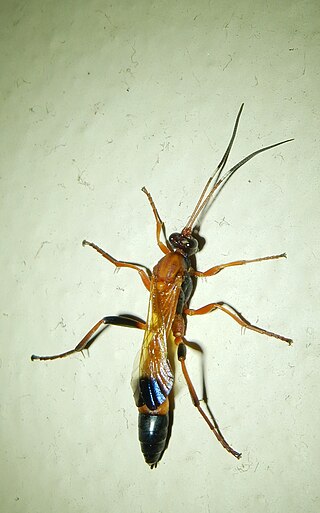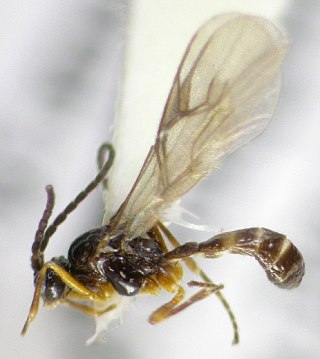
The Ichneumonidae, also known as ichneumon wasps, ichneumonid wasps, ichneumonids, or Darwin wasps, are a family of parasitoid wasps of the insect order Hymenoptera. They are one of the most diverse groups within the Hymenoptera with roughly 25,000 species described as of 2016. However, this likely represents less than a quarter of their true richness as reliable estimates are lacking, along with much of the most basic knowledge about their ecology, distribution, and evolution. It is estimated that there are more species in this family than there are species of birds and mammals combined. Ichneumonid wasps, with very few exceptions, attack the immature stages of holometabolous insects and spiders, eventually killing their hosts. They thus fulfill an important role as regulators of insect populations, both in natural and semi-natural systems, making them promising agents for biological control.

The Braconidae are a family of parasitoid wasps. After the closely related Ichneumonidae, braconids make up the second-largest family in the order Hymenoptera, with about 17,000 recognized species and many thousands more undescribed. One analysis estimated a total between 30,000 and 50,000, and another provided a narrower estimate between 42,000 and 43,000 species.

Megarhyssa, also known as giant ichneumonid wasps, giant ichneumons, or stump stabbers, is a genus of large ichneumon wasps, with some species known for having the longest ovipositors of any insects. They are idiobiont endoparasitoids of the larvae of wood-boring horntail wasps. The ovipositor can be mistaken for a large stinger. This is a genus of holometabolous insects within subfamily Rhyssinae that includes 37 species and belongs to Ichneumonidae, the family of wasps with the highest biodiversity in the world.

The Metopiinae are a worldwide subfamily of the parasitic wasp family Ichneumonidae. Metopiinae are koinobiont endoparasitoids of Lepidoptera. There are 26 extant genera. A bulging shield-like face is diagnostic for members of this subfamily, but many members lack this character.

Acaenitinae is a subfamily of the parasitoid wasp family Ichneumonidae. Female Acaenitinae have a large triangular projecting genital plate.

A wasp is any insect of the narrow-waisted suborder Apocrita of the order Hymenoptera which is neither a bee nor an ant; this excludes the broad-waisted sawflies (Symphyta), which look somewhat like wasps, but are in a separate suborder. The wasps do not constitute a clade, a complete natural group with a single ancestor, as bees and ants are deeply nested within the wasps, having evolved from wasp ancestors. Wasps that are members of the clade Aculeata can sting their prey.

Virgichneumon maculicauda is a species belonging to the family Ichneumonidae subfamily Ichneumoninae. It is a parasitoid of the Cinnabar moth.

Idiogramma is a genus of wasp. It is the only extant genus in the tribe Idiogrammatini.

Trogus is a genus of parasitoid wasp found in the Holarctic and Neotropic regions. It is placed in the subfamily Ichneumoninae and the tribe Ichneumonini. Trogus species are parasites of larvae and pupae of the swallowtail butterfly family, Papilionidae. The genus consists of twelve extant and one extinct species.

Zatypota percontatoria is a species of parasitoid wasps that is part of the order Hymenoptera and the family Ichneumonidae responsible for parasitizing arachnids, specifically those of the family Theridiidae.

Enicospilus is a genus of large Ichneumonidae wasps. They are unusual for wasps in that they fly at night and can be found near porch lights. While these wasps resemble crane flies with long legs and long, thin bodies, the presence of two sets of wings distinguishes them from the single pair of wings of Diptera. There are almost 700 described species of Enicospilus. They are larval parasitoids of Saturniidae.

Ctenochares bicolorus is a wasp in the family Ichneumonidae. Originally from Africa, this species has spread and is considered invasive in many other parts of the world. It is a pupal parasitoid of Chrysodeixis chalcites.

Exetastes is a genus of parasitoid wasps belonging to the family Ichneumonidae.

Aphidius is a genus of insects of the family Braconidae.
Tranosema is a genus of parasitoid wasps belonging to the family Ichneumonidae.
Allomacrus is a genus of parasitoid wasps belonging to the family Ichneumonidae.

Netelia producta is a species of ichneumonid wasp in the subfamily Tryphoninae found in Australia.
Dusona admontina is a species of parasitic wasp belonging to the family Ichneumonidae, subfamily Campopleginae. It is a parasitoid of the larvae of Herminia grisealis.

Dusona leptogaster is a species of parasitic wasp belonging to the family Ichneumonidae, subfamily Campopleginae. It is a parasitoid of Geometrid moth larvae, the two known hosts being Alsophila aescularia and Lomaspilis marginata.
Pimpla disparis is a species of Ichneumonidae wasp. It is a pupal parasitoid of Lymantria dispar, although it is a generalist parasitoid, attacking other species such as Thyridopteryx ephemeraeformis. It is native to the Palearctic realm, and has since the 1970s been introduced to the United States for biological pest control.















